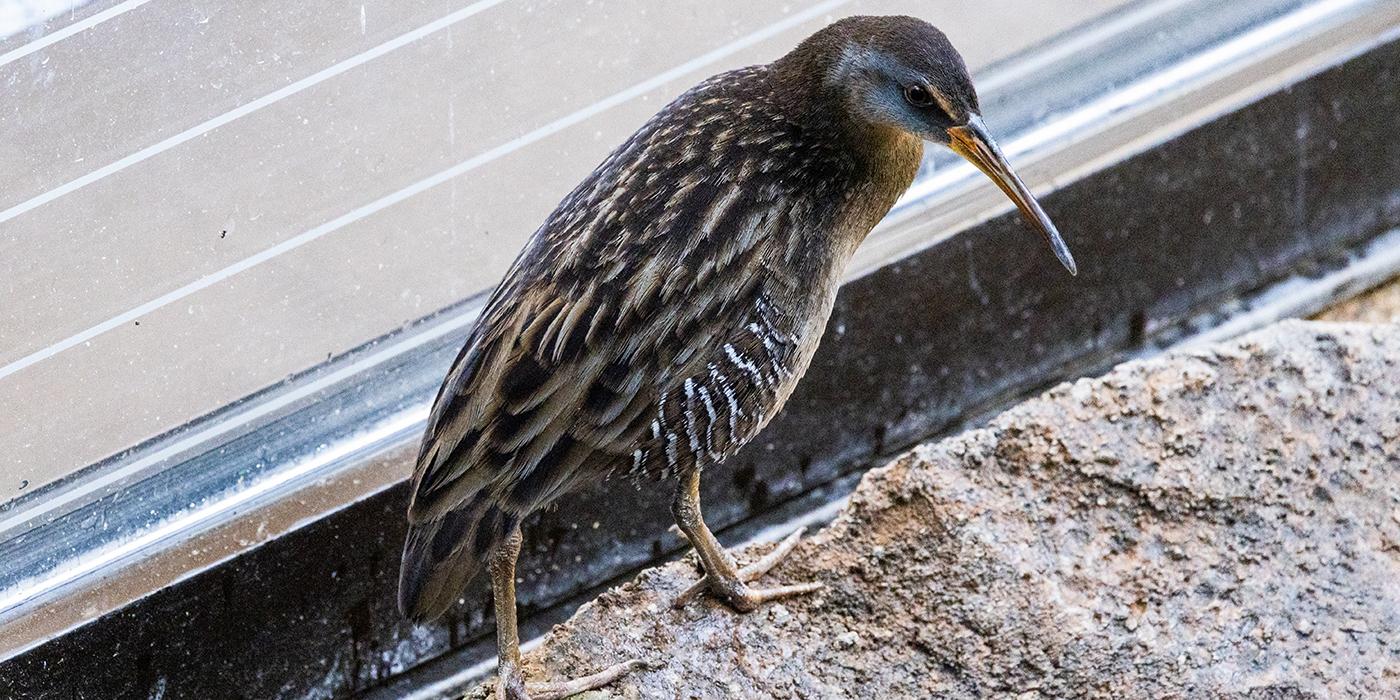Physical Description
Clapper rails are medium-sized terrestrial birds with long, orange bills and short tails. They have gray faces and light, brown-colored heads, while their backs and bellies are dark brown in color.
Size
Roughly the size of a chicken, adult clapper rails stand between 13 and 16 inches (32-42 centimeters) tall and they weigh between 0.4 to 0.9 pounds (0.2-0.4 kilograms).
Native Habitat
Clapper rails can be found along the Atlantic and Gulf Coasts of North America. These birds thrive in coastal wetlands and saltwater marshlands that are dominated by mangroves, pickleweed and cordgrass.
Lifespan
They live about 7 years in the wild.
Communication
The species has a large and varied vocal repertoire, although many vocalizations are subtle and rarely heard.
Adult clapper rails have three main vocalizations:
- Clapper: Given by both sexes. Appears to function as greeting, a means of communicating location of a mate, as nest exchange vocalization, during the pre-copulatory period, or in response to loud noises or vocalizations of other pairs.
- Kek-hurrah: May be abbreviated version of clapper vocalization. Given by un-paired birds of either sex, possibly given by unmated males in summer, or may be "subsong" given by maturing juveniles.
- Kek-burr: Primary call of breeding-age female to attract potential mates.
Food/Eating Habits
Clapper rails forage for food along the edges of marshes, swamps and mudflats. They are omnivorous, taking advantage of whatever plant materials, crabs, eggs, and fish they find. During the winter, they mainly eat vegetation and seeds.
Sleep Habits
Clapper rails are daytime birds, with most of their activity concentrated around dawn and dusk.
Social Structure
During the breeding season, clapper rails pair up with a mate and raise their young together. In the winter months, they tend to be solitary.
Reproduction and Development
Clapper rails are monogamous, pairing up with a mate during the breeding season (from late May to late July) to raise their young. After forming a breeding pair, males take the lead in nest building. Nests are typically constructed in elevated locations like treetops, or in areas on the ground hidden by dense reeds and grasses.
Clapper rails will defend their nesting territory from perceived threats, including other rails. Females lay clutches of between 2 and 16 eggs that are colored white to light brown. Females typically sit on the eggs during the daytime, while the males take over incubation duties at night.
The eggs hatch about 18-24 days. Both parents care for the young chicks. After about one week, the parents divide the brood, with each parent caring for half of the chicks. Chicks are known to travel on the adults' backs during high tides or as the parent moves along the water. The young become independent from their parents after approximately 6 weeks.
Conservation Efforts
As a species, clapper rails are not considered threatened. However, local populations are at risk from habitat loss due to human development, and the degradation of their shoreline habitats as a result of climate change.
Help this Species
Be a smart consumer. Choose products made with sustainable ingredients, such as Smithsonian certified Bird Friendly coffees, which support farmers striving to limit their impact on wildlife and habitat.
Be a responsible cat owner, and keep cats indoors or under restraint when outside. Never release animals that have been kept as pets into the wild.
Organize or attend a stream, river, lake or other waterway cleanup in your area to preserve aquatic habitats for local species.
Smithsonian's National Zoo and Conservation Biology Institute. (n.d.). Clapper rail. Retrieved December 1, 2025, from https://nationalzoo.si.edu/animals/clapper-rail
Animal News

Giant Panda Qing Bao Gets a Checkup ›

7 Spooktacular Animal Facts for Halloween ›

